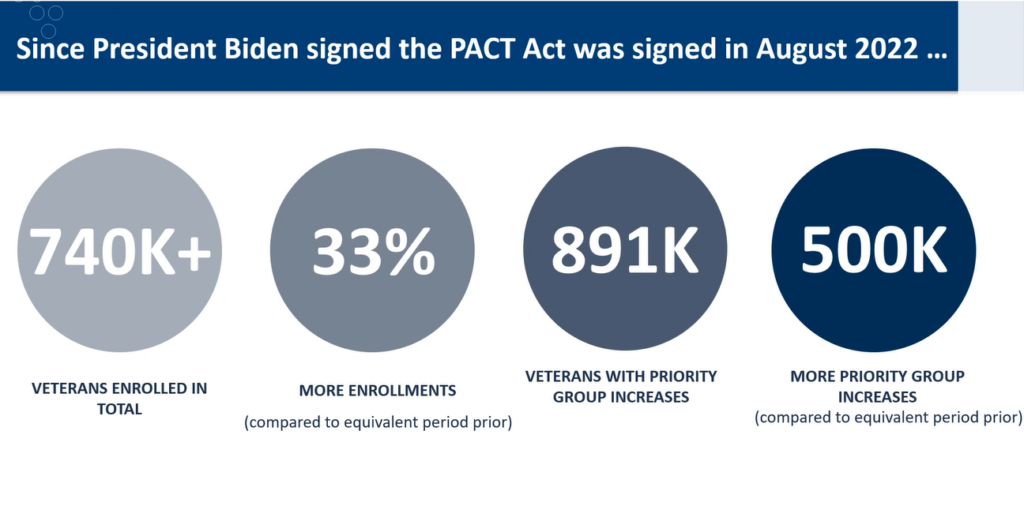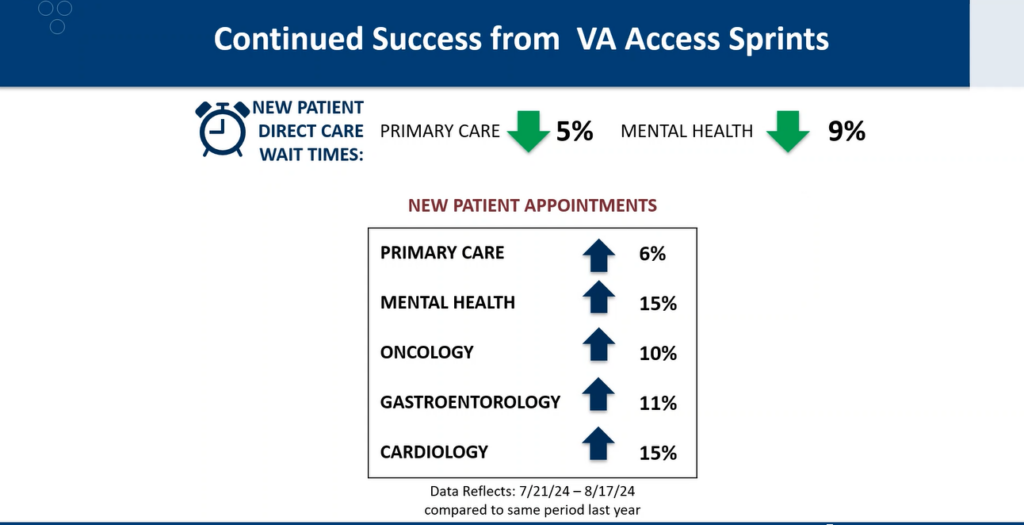VA plans to keep growing health care workforce, if Congress fixes $12B shortfall in FY 2025 budget
The Veterans Health Administration planned for “net-zero growth” for its workforce this year, but kept hiring amid ‘unprecedented health care demand.'
The Department of Veterans Affairs plans to keep growing its health care workforce next year to keep up with a surge in demand for its services.
But before it can do that, the VA is asking Congress for an additional $12 billion to cover a projected shortfall in its fiscal 2025 budget.
Under Secretary for Health Shereef Elnahal said supplemental funding in FY 2025 would allow VHA to increase its headcount by 5,000 employees — compared to its peak staffing in mid-June, when it had a record 400,000 total employees.
The Veterans Health Administration, he added, needs about a third of the money just to keep up with rising costs for prescription drugs and prosthetics. VHA plans to keep hiring to stay ahead of higher-than-expected demand for care under the PACT Act.
The 2022 law made more veterans eligible for VA health care and benefits, if they were exposed to toxic substances during their military service.
“We do think we need to grow above where we are right now in headcount,” Elnahal told reporters Monday.
“What the additional supplemental funding would allow us to do is to make the right investments to grow our capacity even further,” he added.
Elnahal said VHA needs supplemental funding, in part, because medical network directors say they may not necessarily be able to active new clinic space and offer new services, “even though they felt they could recruit the right folks to do it and open new services.”
“Any health system should be able to make investments to be able to meet the public health and care needs of their community. And so, when it comes to activating new clinics, new services, and really catching up to this very high spike in demand, this $12 billion will be needed to do that,” he said. “You need staff for activations. You need new staff to open new services. And right now, our colleagues throughout the field are struggling to do that because of this significant demand growth.”
No longer ‘net-zero growth’
VHA’s current plans to keep growing its workforce diverge from the FY 2025 budget proposal it sent to Congress.
The VA, in that spending request, proposed reducing its workforce by 10,000 positions next year, with most of those jobs coming from VHA.
VA Secretary Denis McDonough told reporters in February that VHA has been managing its workforce in a “tighter fiscal picture,” and is taking a more targeted approach to hiring after it exceeded its hiring targets last year.
VA officials have repeatedly stated that VHA isn’t going through a “hiring freeze.” But Federal News Network previously reported that VHA, at the beginning of this year, advised medical center leaders and human resources professionals on rescinding tentative or final job offers made to prospective employees.
VHA, according to emails obtained by Federal News Network, told officials to only rescind job offers only as an “action of last resort” to manage the overall headcount at their facilities.
VHA planned on “net-zero growth” for its workforce this year, after the agency hired more than 61,000 employees in FY 2023 — its fastest rate of growth in 15 years.
Rather than keep hiring in significant numbers, VHA focused this year on increasing the productivity of its current health care workforce. Through its “access sprints,” the agency increased the number of veterans that each VA provider sees for appointments, and offered night and weekend clinics.
“We began this fiscal year with the goal of essentially managing our growth with the same level of staff by undertaking the access sprints, which was a very explicit effort to improve productivity per clinician,” Elnahal said.
However, he said VHA still grew its workforce by more than 2% this year, “because our teams across the field are making the right decisions where they think they need to bring on these types of critical staff.”

‘Unprecedented health care demand’
More than 740,000 veterans have enrolled in VA care since President Joe Biden signed the PACT Act into law in August 2022 — about a 33% increase, compared to two years before the legislation.
Since the PACT Act was signed into law, 891,000 veterans already enrolled in VA care saw an increase in their priority group, which makes them eligible for a more generous health care coverage package, with lower or no copays.
The VA assigns a priority group to veterans, based on criteria that include disability rating, income level and military service history.
Elnahal said 500,000 of those veterans may not have seen an upgraded priority group without the PACT Act, and that this surge in upgrades contributed to “unprecedented health care demand.”
The agency, so far this year, provided 116 million appointments, and is on track to reach 130 million appointments to veterans by the end of fiscal 2024 — beating last year’s record 120 million appointments.
Through its access sprints, wait times for VA primary care appointments went down 5% for new patients, and down 9% for new patients, between July 21 and August 17.

Elnahal said VA decreased wait time because of increased hiring, and “making sure we are maximally productive as we see patients, while doing everything we can to prevent clinician burnout.”
During this same period, the department saw increased appointments for primary and mental health care, as well as for several categories of specialized care.
“We are seeing more care demand than we expected, although we grew faster than we have in the last 15 years.”
Elnahal said the $12 billion supplemental request would allow VHA to keep adding more appointments and continue driving down wait times.
If we get those funds, we will be able to grow. And we think we need to grow, in order to keep up with demand and not see wait times go in the wrong direction, instead of the right direction as they have been,” Elnahal said.
Community care — health care that veterans received in non-VA medical facilities — accounted for about 40% of total VA care in fiscal 2023. Between October 2023 and July 2024, the number of veterans receiving community care grew by 45%.
Elnahal said VHA is also dealing with significantly higher costs for prescription drugs and prosthetics.
Nearly $4 billion of the $12 billion supplemental would go toward increased costs for prescription drugs and prosthetics.
VA delivered nearly 103 million prescription drugs to veterans so far this year — about a 4.5% increase compared to last year. However, prices for non-retail pharmaceuticals went up an average of 22% between January 2022 and January 2023.
More than half of veterans receiving VA care rely on its prosthetics services — which cover everything from prosthetic limbs to eyeglasses and hearing aids. In the first three quarters of this fiscal year, the VA saw a more than 16% increase in its prosthetics costs.
Leaders of the House Appropriations and House VA committees introduced a bill last Friday that would give the VA $3 billion to ensure the department can keep paying benefits to veterans for the rest of the fiscal year.
That emergency funding bill, however, does not address VHA’s $12 billion shortfall for FY 2025.
The VA gets funding for its mandatory health and benefits programs a year before the current fiscal year to avoid any disruption from a government shutdown.
VA officials told Congress about the $15 billion total budget shortfall in July. Lawmakers say it’s the largest funding gap in the department’s history.
House Republicans are frustrated VA leaders notified them about the budget crunch a few months after submitting their FY 2025 budget request and appearing before both committees to explain their budget needs.
“VA has no excuse for failing to budget for the PACT Act, but we must hold the veterans harmless,” House VA Committee Chairman Mike Bost in a hearing Tuesday. “Dr. Elnahal also tells us there will be a $12 billion hole in the health care funding next year, but VA stonewalls us when we try to get to the bottom of it.”
Elnahal told the committee on Tuesday that the $12 billion supplemental request “would go directly into VA health care, would allow us to grow our workforce instead of having to attrit our workforce to maintain within the budget.”
Copyright © 2025 Federal News Network. All rights reserved. This website is not intended for users located within the European Economic Area.
Jory Heckman is a reporter at Federal News Network covering U.S. Postal Service, IRS, big data and technology issues.
Follow @jheckmanWFED






